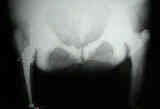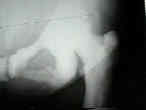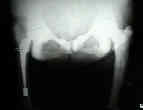- Discussion:
- osteopetrosis is failure of osteoclastic and chondroclastic resorption;
- bones become exceedingly dense;
- marrow space is filled w/ unresorbed dense bone;
- disease results from lack of osteoclastic resorption, leading to thickened bones & exclusion of marrow cavity;
- there is absence of marrow elements & these patients are susceptible to infectious diseases;
- genetics and clinical manifestations:
- severe autosomal recessive form;
- insufficient bone marrow hematopoiesis leads to extramedullary hematopoiesis (causing hepatosplenomegaly);
- pancytopenia causes thrombocytopenia, anemia, and infections;
- patients may also show cranial-nerve dysfunction and visual deficits;
- intermediate autosomal recessive form;
- diagnosed in the first decade and patients tend to survive into adulthood;
- patients have increased bone density, recurrent fractures, macrocephaly, and mild-moderate anemia;
- two autosomal dominant forms both of which are mild;
- patients may have normal life expectancy, but may suffer from recurrent fractures;
- type I: sclerosis of the cranial vault;
- type II:
- rugger jersey spine and pelvic endobones;
- defects in the chloride channel (CLCN7 gene)
- spine:
- some patients may show spondylolisthesis in the cervical and/or lumbar spine;
- most of these patients can be managed non operatively;
- pathophysiology:
- carbonic anhydrase II deficiency (defect in the CAII gene);
- manifestations: renal tubular acidosis, fractures, short stature, cranial-nerve compression cerebral calcification, dental abnormalities;
- osteoclast proton pump deficiency
- defects in the chloride channel (CLCN7 gene)
- responsible for classic type II autosomal disorder;
- Radiographs:
- bones are overly dense with transverse bands in metaphyseal regions & longitudinal striations in shafts;
- pelvis may appear as a bone within a bone and sclerotic vertebrae may have a "rugger jersey" appearance;
- may be difficult to discern the marrow cavity;
- Treatment:
- w/ transfusions of bone marrow elements necessary for the development of osteoclast progenitor cells;
- bisphosphonates are now widely used to treat children, adolescents, and adults with osteogenesis imperfecta;
- pamidronate: doses ranging from 0.5 to 1.5 mg/kg given IV three consecutive days every 3-4 months;
- references:
- Successful treatment of infantile malignant osteopetrosis by bone-marrow transplantation. A case report.
- Cyclic Administration of Pamidronate in Children with Severe Osteogenesis Imperfecta.
References
Osteopetrosis. A morphological study of twenty-one cases.
Total hip arthroplasty in osteopetrosis. A report of two cases.
Osteopetrosis. The pharmaco-physiologic basis of therapy.
Bone densitometry observations of osteopetrosis in response to bone marrow transplantation.
Recent advances toward understanding osteoclast physiology.
Osteopetrorickets. The paradox of plenty. Pathophysiology and treatment.
Carbonic anhydrase II deficiency.
Autosomal dominant osteopetrosis.
Osteopetrosis. Current clinical considerations.
Osteopetrosis. A morphological study of twenty-one cases.
Human osteopetrosis: a histological, ultrastructural, and biochemical study.
Osteopetrosis reconsidered as a curable immune disorder.
Spondylolysis in Children Who Have Osteopetrosis.
Recommendations for fracture management in patients with osteopetrosis: case report




